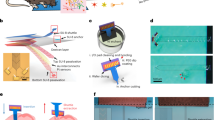Stable recording of the activity of single neurons in the brains of vertebrates can provide investigators with information on the processes underlying the plasticity of the nervous system. In practical terms, recording of the activity of individual neurons over long periods of time is relevant to the development of invasive brain-computer interfaces. We propose criteria for identifying neurons whose activity is present on traces for more than one day. Classification exclusively on the basis of action potential shape is extremely unreliable. Addition of supplementary comparison parameters to the classification, such as the pattern of the distribution of interspike intervals or the characteristics of this distribution, significantly decreases the probability of classification errors. Application of criteria to neurophysiological data allowed us to identify 82 neurons in our experimental data whose activity was present on traces lasting two days or more, and one neuron could be recorded for 94 days.
Similar content being viewed by others
References
Bondar’, I. V., Vasil’eva, L. N., Badakva, A. M., et al., “Quality of recording of neuron signals in the monkey motor cortex using chronically implanted multiple microwires,” Zh. Vyssh. Nerv. Deyat., 64, No. 1, 101–112 (2014).
Bondar, I. V., Leopold, D. A., Richmond, B. J., et al., “Long-term stability of visual pattern selective responses of monkey temporal lobe neurons,” PLoS One, 4, No. 12, e8222 (2009).
Fraser, G. W. and Schwartz, A. B., “Recording from the same neurons chronically in motor cortex,” J. Neurophysiol., 107, No. 7, 1970–1978 (2012).
Jackson, A. and Fetz, E. E., “Compact movable microwire array for longterm chronic unit recording in cerebral cortex of primates,” J. Neurophysiol., 98, No. 5, 3109–3118 (2007).
Li, C., Tripathi, P. K., and Armstrong, W. E., “Differences in spike train variability in rat vasopressin and oxytocin neurons and their relationship to synaptic activity,” J. Physiol., 581, No. 1, 221–240 (2007).
Merchant, H., Naselaris, T., and Georgopoulos, A. P., “Dynamic sculpting of directional tuning in the primate motor cortex during three-dimensional reaching.” J. Neurosci., 28, No. 37, 9164–9172 (2008).
Miller, N. V., Effects of Gravitational Unloading on Otolith Stimulation-Induced Heart Rate Responses in Monkeys: Auth. Abstr. Mast. Thesis in Biol. Sci., Institute of Medical Biological Problems, Russian Academy of Sciences, Moscow (2008).
Op de Beeck, H. P. and Baker, C. I., “The neural basis of visual object learning,” Trends Cogn. Sci., 14, No. 1, 22–30 (2010).
Op de Beeck, H. P., Wagemans, J., and Vogels, R., “Effects of perceptual learning in visual backward masking on the responses of macaque inferior temporal neurons,” Neuroscience, 145, No. 2, 775–789 (2007).
Polikov, V. S., Tresco, P. A., and Reichert, W. M., “Response of brain tissue to chronically implanted neural electrodes,” J. Neurosci. Meth., 148, No. 1, 1–18 (2005).
Serruya, M. D., Hatsopoulos, N. G., Paninski, L., et al., “Instant neural control of a movement signal,” Nature, 416, No. 6877, 141–142 (2002).
Taylor, D. M., Tillery, S. I., and Schwartz, A. B., “Direct cortical control of 3D neuroprosthetic devices,” Science, 296, No. 5574, 1829–1832 (2002).
Tolias, A. S., Ecker, A. S., Siapas, A. G., et al., “Recording chronically from the same neurons in awake, behaving primates,” J. Neurophysiol., 98, No. 6, 3780–3790 (2007).
Vigneswaran, G., Kraskov, A., and Lemon, R. N., “Large identified pyramidal cells in macaque motor and premotor cortex exhibit ‘thin spikes’, implications for cell type classification,” J. Neurosci., 31, No. 40, 14,235–14,242 (2011).
Author information
Authors and Affiliations
Additional information
Translated from Zhurnal Vysshei Nervnoi Deyatel’nosti imeni I. P. Pavlova, Vol. 64, No. 6, pp. 693–701, November–December, 2014.
Rights and permissions
About this article
Cite this article
Vasil’eva, L.N., Badakva, A.M., Miller, N.V. et al. Long-Term Recording of Single Neurons and Criteria for Assessment. Neurosci Behav Physi 46, 264–269 (2016). https://doi.org/10.1007/s11055-016-0227-8
Received:
Accepted:
Published:
Issue Date:
DOI: https://doi.org/10.1007/s11055-016-0227-8




